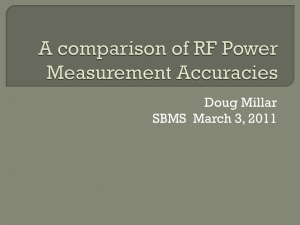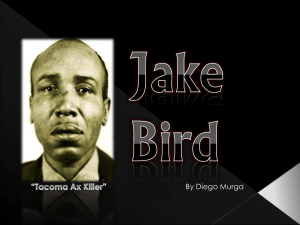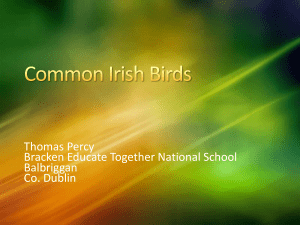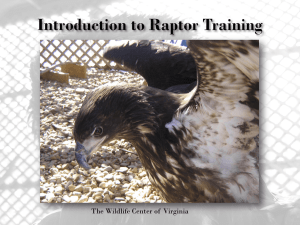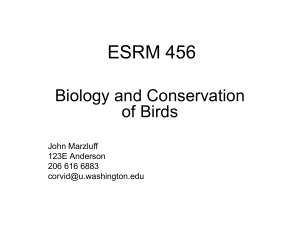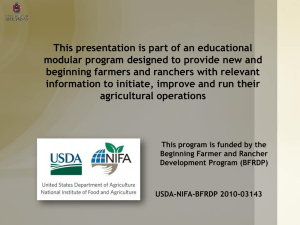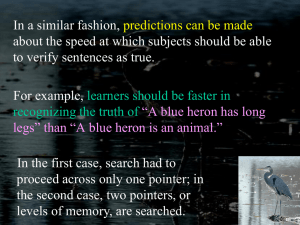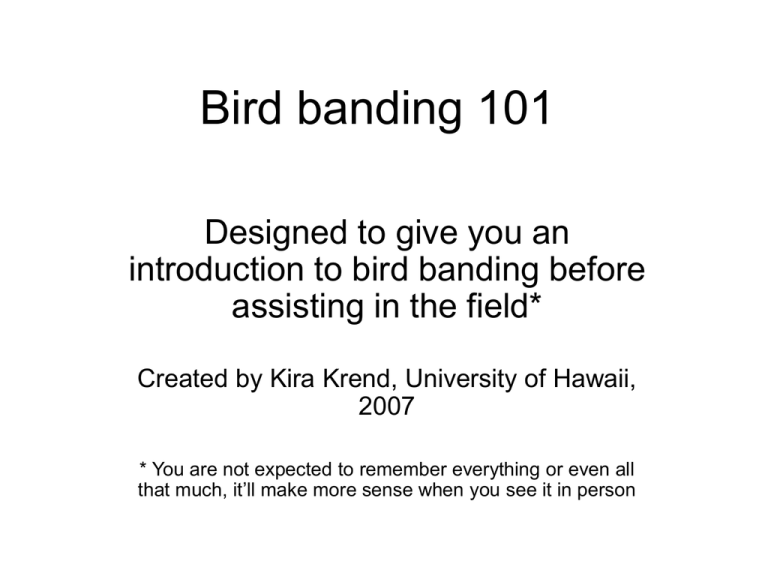
Bird banding 101
Designed to give you an
introduction to bird banding before
assisting in the field*
Created by Kira Krend, University of Hawaii,
2007
* You are not expected to remember everything or even all
that much, it’ll make more sense when you see it in person
Things to bring
•
•
•
•
•
•
•
Sturdy shoes, cleaned of seeds
Lots of water
Lunch
Sun protection (hat, sunscreen)
Rain gear
Book or other distraction for downtime
Optional: mosquito protection, binoculars,
camera
Setting up- nets
• Teles = telescopic fishing poles with spikes
attached
• Poles= metal conduit
• Nets: come in 6, 9, or 12 meters
• Rope and stakes: used to stabilize teles
and poles
– Don’t forget to tie down net
• Will be shown how to properly set up and
secure nets
Setting up- nets
Tele net up
Pole net up
Humans
• Warning sign put at each end of nets, to
prevent people from running into net or
trying to “help” stuck birds
• Will have people on trails- make sure to
engage, tell them what’s going on, and
escort them past nets if necessary
• Be especially aware if they have dogs with
them and will be passing directly by pole
nets
Setting up- banding station
• Where we band & process birds
• Tarps- one for ground, one for
shade/raincover
• Net bag= black&red bag with nets
and bird bags
• Navy blue bag (swag bag)= has
rope, stakes, mallets, duct tape
• Kit= banding kit, a tackle
backpack, with all banding
supplies
• Book= yellow notebook where
data is recorded
• First aid kit is in Kira’s backpack if
ever needed
Net checks
• Number of nets open ranges from 4-8; usually open from
~8am-4:30pm
• All nets checked every 20 min (sometimes called ‘check
time’ or ‘net run’)
• More often if gusty or rainfall
• Carefully scan entire area of net, if any part not clearly
visible, go over and look; check bottom line in pole nets
specifically for birds by tugging
• Wiggle pole slightly to check for stability- reset if loose
• If net is caught in vegetation, loosely try to pull free and
readjust net. If doesn’t come out, leave and tell to Kira
or trained person upon return
Net checks- there’s a bird!
• If there is a bird in the net: call Kira or trained
person on walkie right away
• ALWAYS bring a walkie if alone- in a pinch,
yelling “bird!” will work too
• State what net you are at (nets will be identified
as P1, P2, etc beginning of the day) how many
birds are in it, and species if you know
• You will be given instructions to either come
back and help at the banding station, or to
continue checking the rest of the nets
Extracting a bird
• Only Kira and fully trained banders may take birds out unsupervisedothers will be observed once they have volunteered a few days and
watched extractions
• Getting a bird out of a net (for volunteers with some experience only)
– First: figure out what side of net the bird flew in- this is vital
– Get a good grip on bird, and begin “backing” them out- usually tail first,
then feet, wings, and finally head- more of an art than a science
– Keeping the bird from bending into unnatural positions, and careful
movements are key to preventing injury
– Lots of nasty ways a bird can be caught: thighed, tongued, backpacked,
double bagged
– If having trouble, always acceptable to let an experienced bander take
over, particularly if you’ve been working for a while and/or bird seems
stressed (eyes closing, lethargy, open mouth)
• Lots of practice is the only way to learn this skill, don’t get frustrated
if it is difficult at first
Extracting a bird
The grips
• 2 most common:
• The banders grip= neck between pointer
and index finger of non-dominant hand,
bird resting in palm
• The photographers grip=pointer and index
behind bird’s thighs, with thumb for
support, dominant hand
• In large birds, occasionally use ice cream
cone grip, which is just like it sounds
The 2 main grips
Bander’s grip
Photographer’s grip
Bird banding
• After extracted, bird placed into bag, carried
back to banding station
• Native birds processed first, then in order of
capture for introduced birds- stressed birds can
move up in the order
• Waiting birds hang from branches, or are on
someone’s lap- NEVER lay a bag with bird in it
on ground, even for a moment
• Every bird, native or introduced, gets processed
Native Forest Birds of Oahu
Oahu Amakihi- OAAM
(female)
Apapane- APAP
Oahu Amakihi- OAAM (male)
Others unlikely to catch: Oahu Elepaio and Iiwi
Introduced Oahu Forest Birds
Japanese white eye: JAWE
Red-whiskered bulbul: RWBU
Common Waxbill:COWA
Red-vented bulbul: RVBU
Introduced Oahu Forest Birds
House finch: HOFI
Japanese Bush-warbler: JABW
White-rumped shama: WRSH
Red-billed Leothrix: RBLE
Introduced Oahu Forest Birds
Red-crested cardinal: RCCA
Nutmeg mannakin: NUMA
Northern Cardinal: NOCA
Chestnut Munia: CHMU
Introduced Oahu Forest Birds
Zebra Dove: ZEBD
Common Myna: COMY
Yellow-faced grassquit: YFGR
Spotted Dove: SPDO
WEIGHT
• Done first- turn scale on, zero if needed. Check
to be sure in grams
• Balance bird in bag on scale- record in WEIGHT
column on second page
• After processer has removed bird from bag,
weigh bag, and record in WEIGHT column as
what should be subtracted to get bird only
weight
• (Bird+bag) – bag = Bird weight (calculated later)
• Example in book: 45.1 – 32.7
Bird banding- data collection
• First column: SPE/CAP
• SPE: Species. Every bird has a standard 4
letter code, i.e. OAAM, JAWE, RBLE. If don’t
know the code, ask.
• CAP: Capture.
– I= initial capture, never been banded
– R=recapture, already has a band
– D= daily double, bird caught for the second time in a
day. D also stands for dumb bird
• Example in book: JAWE / I
NET/TIME/OBS
• Next column after SPE/CAP
• Net: which net bird caught in: P1, P2, etc. Ask if
you didn’t see which net it came out of
• Time: time of net check that bird came from:
round to closest 10min, use military time,i.e.
1:40pm is 1340.
• Obs: Observer, the initials of the person
processing the bird. Kira=KLK, Sam=SAB,
Mark=MCD. If you don’t know/remember, just
ask.
• Example in book: P2/1020/KLK
The Band
• We call it ‘banding’ referring to the uniquely
numbered aluminum band put on each bird.
• To get a band ready to put on a bird: find
appropriate size band- here are the most
common birds’ band sizes:
–
–
–
–
–
–
0: JAWE, COWA, NUMA, CHMU
1: OAAM, APAP, HOFI
1B: RBLE
1A: RWBU, WRSH
2: RVBU
If you don’t know, or are even a little unsure, just ask!
The band
• Once you have the band, place band onto
prongs of banding pliers so the edges line
up with the opening (makes no sense until
you see it).
• Squeeze pliers slowly band opens evenly
• Place band in other pair of pliers in
appropriate hole, hand to bander
Banding the bird
• For volunteers with some experience only:
• When placing band on, supporting leg is key- in
banders grip, hold toes with index and pointer,
and tarsus joint with ring finger and thumb.
• Either leg is fine, whichever is more comfortable
in your grip
• Place band around thin side of leg, turn 90
degrees, watch edges come together
• A well banded bird has no overlap and no space
between matching edges
Recording banding info
• Once the band is on the bird (and not before, that’s bad luck) the
bander will read aloud the band number
• Bander will give a 3 or 4 number PREFIX, pause, and then give a 5
number SUFFIX, i.e., “okay, band num is 1601, 66482, on the left”
• Recorder records each in the appropriate column, and reads back
the suffix while the bander is looking at the band to double check
• LF and RT columns refer to which leg the band is placed on, and will
say “on the left” or just ask. Put AL (for aluminum) in either LF or RT,
and a dash in the other.
• When putting a set of color bands on, they each have codes (i.e.
DB= dark blue) and will be given to you specifically, with which leg
and in what order (we don’t do this much)
• Example from book: 1601 66482 AL –
Other band number info
• Important: record the SUFFIX in the first
column of the next page, to keep birds
straight.
• Each bird has 1 line that spans 2 full
pages.
• Always good to watch if suffixes are in
order- if using the same size band, they
should be- alert the bander if not, to look
for skipped or possibly dropped bands.
Blood sample
• Done by trained person, generally the last thing
to be learned
• Do this after weighed and banded
• Set up: helper/recording can put the following
items on the BLOOD BLOCK
– Qtip, dipped in water on one end
– Needle, taken out of package and ‘unlocked’, set in
cap
– Capillary tube
– Tube of buffer, opened
Blood sample
•
•
•
•
•
•
•
•
•
•
•
To take blood sample from brachial vein (note: for experienced banders only)
Place hand with bird on lap or knee for balance
Extend wing with index and forefinger, use qtip to expose brachial vein
Once can easily see and have a clear shot, take needle, bevel side down, and nick
vein at approx 45 deg angle
Remember, don’t want to poke through entire vein, just puncture
Going slower can help prevent hemotomas
If no blood comes out, you either missed, or bird has shut down peripheral circulation.
If you think you missed and just moved around skin, try again. But if you know you
hit and there was no blood, give up, or let Kira try on the other side.
Once blood flows, use capillary tube to suck up- gravity can help. If getting little
blood, try pumping wing a bit
Place capillary tube into buffer, cover wound with dry qtip end.
After sample taken, check to see if bird is bleeding a lot, or after pressure has been
placed
If yes, treat with styptic powder
Blood sample
• Helper/recorder finishing the blood sample:
• Open blood blower, place over capillary tube, and turn to push blood
into buffer
• Can go up and down a few times to get all blood out of tube
• NOTE: do NOT get blood into blower- will cause contamination of
samples. If you do by accident, alert experienced person who will
take it apart and sterilize it
• Close buffer tube (make sure fully closed) and shake well
• Label with top and side (textured area) with blood log number
• Put capillary tube and CLOSED needle into sharps container, used
qtips and needle packaging into trash
Recording blood info
• On second page of record, BLOOD LOG/AMT
• BLOOD LOG is a letter (based on site) and
number code- go with the next number. If first of
the day, ask experienced person to look up the
last one
• AMT is the amount of blood, measured by the
proportion of the capillary tube filled, can be
anywhere from 0.1 to 2.0 (if fill up 2 cap tubes)
• Example from book: HON178/0.7
BP/CP/M/F
• Next column, beginning of second half of first page
• Note: scoring info for semi-experienced volunteers onlydon’t get overwhelmed. If you are recorder, a bander will
just tell you the number to record in the BP column.
• BP= Brood patch
– 0: No brood patch at all- breast and abdomen area has feathers
on it
– 1: Area is smooth and without feathers, and a distinct ‘outline’ of
the area is present
– 2: Area is becoming vascularized
– 3: Area looks nasty, like a blister
– -1: Like a 1, but “coming down” at the end of breeding season
BP/CP/M/F
• CP= Cloacal protuberance
– 0: pointing down, no swelling
– 1: pointing up, swelling at base
– 2: pointing up, swelling throughout
– 3: pointing up, swelling at top
• If not sure, ask, or check again at end,
could be fecal matter
• M= CP metric. Using ruler, measure
length of CP only, not feathers on it.
BP/CP/M/F
• F= Fat, looking into at the furcular hollow (wishbone
area)- birds skin is see through, can see yellow fat when
present
– 0: No yellow at all
– T: stands for trace- can see yellow, but does not connect to make
the whole area coated with yellow
– 1: yellow across whole hollow, but does not fill in, still hollowed
out
– 2: yellow fills up hollow until it is full and straight across
– 3: yellow across bows out of hollow- a real fatty
• As a record, you will something like this: “Ok, BP zero,
CP zero, met of 2.5, and Trace of fat”
• Which you will then record as 0/0/2.5/T.
AGE/B
• Next column says AGE/B, the age of the bird, and B referring to ‘by’
as in how we determined age or sex
• Age
– AHY: After Hatch Year. An adult bird
– HY: Hatch Year. A juvenile bird
– AHYQ or HYQ: Q refers to question, if bander is unsure because it is
unclear
• Determining age- B
– P: Plumage- young birds tend to have different plumage patterns than
adults
– R: Reproduction- only AHY birds will have BPs or CPs, indicating
reproductive activity
– G: Gape- young birds often have fleshy extra skin around the edges of
their bills
• Example from book: AHY/P
SEX/B
• Next column is SEX/B, which is the sex of the bird, and how it was
determined
• Sex
– M: Male
– F: Female
– U: Unknown- in HY birds or in species where males and females look
alike, and there’s no evidence of CPs, sex is unknown
– FQ or MQ: Questionable identification, if it isn’t clear to the bander
• Determining sex- B
– P: Plumage-some species males and females have different plumage
patters
– R: Reproduction- only male birds have CPs- both sexes can have BPs.
– M: Metric- in a some species, males and females are different sizes
• Example from book: M/P
DISEASE
• This column refers to any evidence of past or present
pox infection, usually showing as swelling on fleshy body
parts (most common on legs, feet, toes, but also check
edge of bill and around eyes), or deformities from past,
healed infection
–
–
–
–
L or R: Leg with disease
SW, SO, M, D: What’s wrong: Swollen, Sore, Missing, Deformed
T,C: Toe, claw
Toes labeled 1-4, counting from the inside, ending with hind
• Example from book “Left Missing Toe 3” = LMT3
MOLT
• Molt is when new feathers are growing in, identified by
their cylindrical sheaths
• We record were molt is located on a bird:
– HD=head, BR=breast, AB=abdomen, VT=vent, TTC= top tail
coverts, UTC=under tail coverts, TG=thigh, FK=flank, BK=back,
RP=rump, TWC= top wing coverts, UWC=under wing coverts,
RETS=retrices (tail feathers) P= Primaries, S= Secondaries
– Wing feathers are counted out, starting with the outermost
Primary= 9, then 8…1, then the next feather is Secondary 1….9.
L or R also noted, i.e. LP6= left primary 6.
– When recording, the bander will say the regions, and if you don’t
know the code, just ask them to say that as well
• Example from book: BR,BK,UTC,LS6,RS4
– If all doesn’t fit into molt box, put an elipsis (…) and then in the
NOTES section, put M= and then continue listing molt regions
ECTO/COL
• Ectoparasites are lice and mites in the feathers of birds- we record
their presence in the same regions (and using same codes) as molt
– If any ectos, Y in Ecto column, and then turn to NOTES section. If no
ecto, N.
– E= eggs. Light colored, dandruff looking specks that stay on feathers
when you blow on them or try to move them
– ASL=adult stage lice. Difficult to id from eggs without a hand lens, but
can sometimes see them crawling. When in doubt, call it eggs
– ASM= adult stage mites. Larger and faster than lice, and tend to climb
onto your hands from the bird
• If a bander says “we have eggs on head, and adult lice on primary
wing barbs” the example in the book would be Y in ECTO column,
and in the notes E=HD, ASL=PWB
• If a sample of ectos are collected, a code will go in the COL column,
i.e. E37. If ectos are many body areas, write in the notes where the
sample came from: E37= HD
MORPHOMETRICS
• The last thing we do is take
measurements of the bird. All are in mm.
• WING/TAIL: wing measurement, pushing
down to flatten wing,and length of longest
tail feather
• L BILL: Long bill, or bill length
• D/W: Depth and Width of bill
• TARSUS: from notch in ankle to top of
foot- seeing it will make more sense
STRESS BARS
• When birds are nutritionally stressed
during molt, the result can be horizontal
bars on flight feathers that lack pigment
• When surveying for molt and ecto, the
bander may say “Two faint stress bars on
Tail”
• Recorded in the NOTES as “2 faint SB on
T”
Releasing a bird
• Before letting go, the bander will ask, “is this bird
done?” and the recorder will look back at the
entry and make sure all spaces are filled in, and
if yes, bird is done
• To safely let go of a bird, put in bander’s grip and
turn bird right side up in your other palm, and
release grip
• This gives the bird a place to sit for a moment if
needed without falling. If they don’t fly away,
move hand up and down slightly

